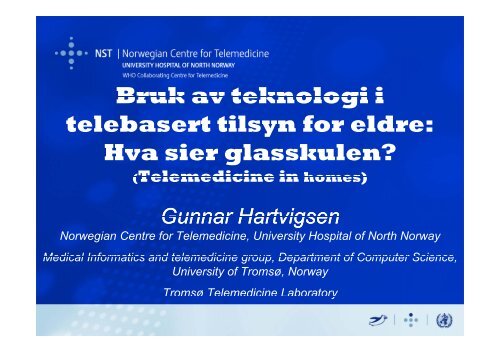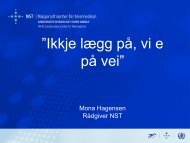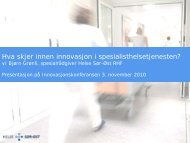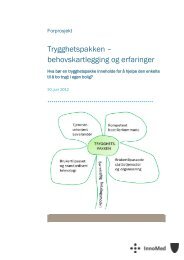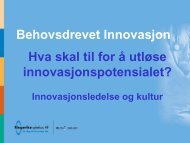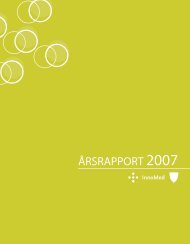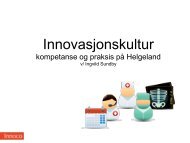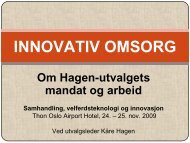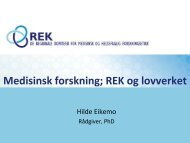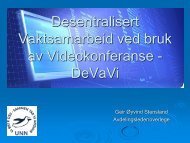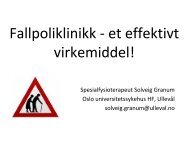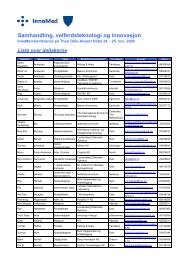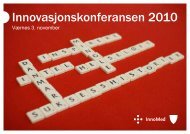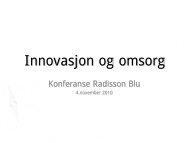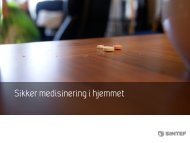y Hva sier glasskulen? - Innomed
y Hva sier glasskulen? - Innomed
y Hva sier glasskulen? - Innomed
You also want an ePaper? Increase the reach of your titles
YUMPU automatically turns print PDFs into web optimized ePapers that Google loves.
Bruk av teknologi itelebasert tilsyn for eldre:<strong>Hva</strong> <strong>sier</strong> <strong>glasskulen</strong>?(Telemedicine in homes)Gunnar HartvigsenNorwegian Centre for Telemedicine, University Hospital of North NorwayMedical Informatics and telemedicine group, Department of Computer Science,University of Tromsø, NorwayTromsø Telemedicine Laboratory
Annen kilde:Mitt hjem erRapporten ertilgjengelig framitt hospitalGunnar HartvigsenNasjonalt senter for telemedisin,Universitetssykehuset Nord-Norgewww.telemed.noInstitutt for informatikk,Universitetet i Tromsø
Established in the UK in 1957, Tunstall isthe world’s leading provider of telecare andtelehealth solutions. Operating in 30countries and employing over 1000 people,Tunstall supports 2.5m people around theworld.http://www.tunstall.co.uk//
http://www.komialt.dk/index.php?id=1033
World NewsDriving forces towardstelemedicine in private homes• Seniors want to stay intheir own homes• Increasing number ofelderly• Medical advances• Technologicaldevelopment• “Chronic” crises incare"For the rest of humanhistory, there are goingto be more old peoplethan young..."—Dr. Joel Cohen, Professorof Populations, Rockefellerand Columbia Universities
67+ NorwayHighMediumLow
Some figures from Sweden• 65+: 2002 17%; 2035 24%• 2002: 256.000 employed in care (”vård ochomsorg”) i municipalities.• 10 next yrs: 240.000000 need to be recruited tocare (Kommunförbundet 180.000 in 2000-2010)• Towards 2030: effort for elderly care must beincreased with 140 % (Even though familycontinues to contribute in the same way asbefore and that seniors’ health remains thesame. Today 300.000 manyears.)Ställdal, E., Caesar, M., Larsson, M. (2002). Att bo och vårdas hemma: IT ger nya möjligheterinom vård, omsorg och boende. Stiftelsen for kunskaps- och kompetensutveckling. (www.kks.se)
Some figures from SwedenCanada will be short78,000 Registered Nurses• 65+: 2002 17%; 2035 by 2011. 24% This shortage is• 2002: 256.000 employed compounded in care (”vård by the ochfactomsorg”) i municipalities. that within 15 years, 50% of• 10 next yrs: 240.000000 employed need to nurses be recruited will be oftocare (Kommunförbundet 180.000 retirement in 2000-2010) age.• Towards 2030: effort for elderly care must beincreased with 140 % (Even though familycontinues to contribute in the same way asbefore and that seniors’ health remains thesame. Today 300.000 manyears.)Ställdal, E., Caesar, M., Larsson, M. (2002). Att bo och vårdas hemma: IT ger nya möjligheterinom vård, omsorg och boende. Stiftelsen for kunskaps- och kompetensutveckling. (www.kks.se)
Aging and cost of carehttp://www.medetel.lu/download/2006/parallel_sessions/presentation/0407/Richardson.pdf
Implications• Increased need for appropriate homes• Increased lack of care personnel• Increased waiting lists• Increased need for assistance (care) fromfamily members• Increased professional private care• Increased use of assisted homes as nursinghomes• Increased frustration
ImplicationsIt is impossible to• Increased need for appropriate homes• Increased lack of care personnel• Increased waiting lists• Increased need for assistance (care)gfromfamily members• Increased professional private care• Increased use of assisted homes as nursinghomes• Increased frustrationenvision that there willbe a nursing homeavailable for all elderly
And the answer is …• Telemedicine and telecareservices(By the way, what was the question?)• In addition: focus onhealth promotion anddisease prevention
http://www.medetel.lu/download/2006/parallel_sessions/presentation/0407/Richardson.pdf
Are hospitalsa thing of thepast?
Senior citizens’ home of today
Senior citizens’ home of tomorrow
TelecareExamination / testTransmissionAlarmcentral(Continuously) telecareReal-timeconsultationThedoctor’sevaluation
Alternative to technology?
<strong>Hva</strong> mener dereldre selv?
Feedback from health care workersWhybotherwith suchsystems?”You have noclue about whatour working dayin home care islike.””This is liketrying to build abridge to themoon.”
”Skremmende Skremmende, ” <strong>sier</strong> deeldre–Overvåkning av kroppsfunksjoner? Nei jeg tror jegvar blitt gal etter en time med kameraer overalt, <strong>sier</strong>Ivanna Pedersen (73) indignert.–Sensorer i vinduet? Det beste hadde vel vært at detikke hadde vært det. Da hadde de vel blitt kvitt oss,skjemter de.–Det høres ut som om vi skal roboter. Det blir jo ikkenoe menneskelig igjen, fortsetter Ivanna Pedersen.Fra ”Nordlys”, onsdag 25 april 2001
”Skremmende Skremmende, ” <strong>sier</strong> deeldre–Hvorfor skal vi være forsøkskaniner? Det bestehadde vært at de som pønsker ut jævelskapen haddefått oppleve hvordan det føles. Det virkerskremmende og skummelt å være overvåket fra duslår opp øynene til du skal legge deg. Nei da håpa æat æ daue før deinn tid, <strong>sier</strong> de friske damene.Fra ”Nordlys”, onsdag 25 april 2001
”Skremmende Skremmende, ” <strong>sier</strong> deeldre–Ser dere ingen positive sider med dette?–E’ du toillat, nei det er forkastelig at de har sliketanker om oss. Hvorfor skal de prøve det på oss? Vihar betalt skatt hele livet og vil ha en verdigavslutning på livet, mener Edith Bergli (83).Fra ”Nordlys”, onsdag 25 april 2001
Vital parameters to bemeasured• Pulse and heart rhythm• Movement/fall• Body temperature• Skin humidity• Blood pressure• Pulse wave velocity (PWV)• Blood oxygen saturation (SpO 2 )• Electrocardiogram (ECG)• Blood values
Telecare andTelemedicine in privatehomes
Examples on telecareTelemedicine stationFor the patientFor the doctorhttp://www.ttuhsc.edu/telemedicine/
Examples on telecareOxygen therapy• Long-lasting oxygen treatment– Monitor the patient's t' reaction– Reports:• Oxygen levell• Alarms or malfunction– Contact technician or orderrefill
Measures lungfunction (volume, speed)Spirometry
Examples on telecareAsthma• Purpose– Early detectionof changes inthe condition– Monitoring effectof newmedication– Values recordedand transmittedI.Bruderman, Telemedicine Journal 3(2) 127-133
Examples on telecareCardiology• Intensive monitoring at home reduces theneed for hospitalization for elder patientswith severe Congestive Heart Failure• Some reported results:– Improved functional capacity– Reduced hospitalization: From 26 days to 6days/yearyR.Kornowsky et al, JACC, 02/1994, 433A, 966-78
Blood glucose measurement(Noninvasive glucometers)e • Health watch• Wearable computer controlled insulinpumps• Combined in the future?
Safety24 hour coverageAlerts enable quick responseHelps you decide when tointerveneIndependenceSeniors live at home longerPrivacy protectionGuards againsthospitalization and fallsConveniencee Personalized to their livingpatternsAutomatic alertsProfessional installationtiWell-BeingPeace of mind for you bothPreserves comfort and dignityEnhanced quality of life
Site 1
Examples of telcareControl with medicationMany senior citizens usesmedications on a daily basis,and > 25% of the seniorpopulation takes 4 or moreprescriptions daily.Controlling the timing anddosage of the medicationbecomes important.For many elderly, rememberingwhat medication they aresupposed to take areproblematic.
Examples of telcareControl with medication• Mary, 80 years old• Installed pill dispenser• The dispensercommunicates with themedication list inPASKOR (EHR)• Mary’s only complaint:“The pill box shouldspeak Norwegian, notEnglish”
www.ila.org.il/_Uploads/35Shortliffe-ILAMI-Handout.pdfUSA:100.000 dødsfall prår kan tilskrivesifeilmedisinering
MotivationImmobile• For immobile persons, avisit to the doctor in order toget new medication orchange existing prescriptioncould be a real challenge.• For some medications, avideoconference-baseddoctoral visit could besufficient for ordination ofe.g. painkillers.
Technology may save lifesin other ways, too• Easter, 2003: The policefound Ms. JohanneWilhelmsen in her living roomlying on the floor• She had been lying there forthree days• Cooled down – bodytemperature re below 30 °C• Died at the hospital thefollowing day• A pill dispenser may haveprevented the outcome
Examples on telecareActivity monitoring andcontrolWeight sensors fromPioneer Medical Systems.Wearable fall detectionsensor from Lifesystems.comFall detection sensorsrecording acceleration +position.
Examples on telecareActivity monitoring and controlSensorinput
The Aware homeExamples on telecareActivity monitoring and control
Detection of inactivity• Detect whenrefrigerator fiareopened, bathroomuse, etc.• Notify health carepersonnel afterlack of activityduring a certaintime
Example on telecarePosition monitoringWherifyWireless’sGPS watchfor children
Exampels on telecarePosition monitoringGPS Universial Locator GPS Offender Locator
Health monitorLoughborough University“... the system enables adoctor to observeremotely up to fourdifferent medical signalsfrom a freely movingpatient. Signals that canbe transmitted include theECG, blood pressure,oxygen saturation andblood glucose level. ”www.theengineer.co.uk/Articles/Article.aspx?liArticleID=292374
• Since itsconception in2002, ThinkPositive Medicalhas been strivingto make cellphonesan integral part ofthe way patientsmonitor theirhealth.
Take 2 Shots and Have YourLiver Call Me in the Morning• The Bionano Research Team of the Korea Research Institute ofBioscience and Biotechnology developed a bio sensor to measureGOT (Glutamine Oxaloacetic Transaminase) and GPT (GlutaminePyruvic Transaminase) in blood and linked the sensor to a mobilephone. The result can also be transmitted to hospitals, said theresearch team.
Laptops with Integrated ECG• Taiwan basedMicro-StarInternational(MSI) has unleashthe first personallaptop computerwith an integratedelectrocardiogramfunction.
http://www.medgadget.com/archives/telemedicine/“Big Doctor isWatching You”• A new system being tested at RushMedical Center allows doctors to'interrogate' pacer / defibrillators,remotely, at will. And the docs have access to much more info,as well. It's called the LATITUDE system and researchers aretrying to see if it reduces the frequency of congestive heartfailure (CHF) hospitalizations:• Unlike other remote devices which only transmit data if certainparameters are out of range, the LATITUDE system uploadshealth information that can help physicians monitor the day-todaychanges in patients. In addition to the data stored before,during and after an arrhythmia, the system employs awireless weight scale and blood pressure monitor to recordvital statistics crucial for the management of cardiac failurepatients. An abrupt change in weight could indicate worseningheart failure.
“Big Doctor isWatching You”• "This sophisticated systemallows physicians to manage thepatient much more closely. Thesame information that wouldnormally require a visit to theoffice every few months cannow be downloaded to thephysician at anytime withoutthe patient ever leavinghome," said Dr. KousikKrishnan, a cardiacelectrophysiologist at Rush.LATITUDE Blood PressureCuff and ScaleThe Communicator automatically collects information from yourdevice on a schedule set by your doctor. It then sends thisinformation through the phone line to a secure website that yourdoctor can access with a password. Best of all, you won't feel a thing.LATITUDE Communicator
“Big Doctor isWatching You”• According to Krishnan, the LATITUDE system provides addedpeace of mind for the patient. The physician can remotelycheck if the defibrillator is working correctly and assessbattery life. If the patient feels the defibrillator activate, heor she can transmit the rhythm information immediately.The physician can quickly analyze the data and determine if theshock was appropriate or if the patient needs to go to thehospital. "Now with patient information available weekly, or evendaily if needed, we can better monitor our patients," said Dr.Krishnan. "We can pick up abnormalities sooner and act onthose before they become serious."• So, it seems this system can suggest to doctors when theirpatients are noncompliant with meds, or engaging in 'strenuousactivities.' Kind of creepy, and enough to raise anyone's bloodpressure. But then again, CHF is a heavy burden itself, andstaying out of the hospital is the first requirement forindependence.d
Exampels on telecareWound examinationNorwegian Centre for Telemedicine
BloodsugarWeightBloodoxygenCameraBloodpressureStethoscopeth ThermometerECG
Secure NetworkInternet-Enabled Provider PCPatient Home MonitorDirect Dial-UpFirewallApplicationServerDatabaseHTTPServerFirewa allInternet
KIOSK PROGRAM
WHAT THE MONITOR MEASURES• Monitors weight to 500 lbs., blood pressure, heart rate,02saturation and temperature when needed• Can also monitor glucose and lung function measurements• Asks subjective yes/no questions for a more complete picture ofhealth• Kiosk meets ADA specifications and transmission of data isHIPAA compliant• Monitor can be programmed in eleven different languages
HOW DOES IT WORK• Information transmits to the office for reviewby the central station clinician• The resident will be contacted to review anyirregularitiesiti• Resident are encouraged to contact their MDwhen potential problems are uncovered
http://www.gadgetguy.com.au/irobot-scooba-review-151292-14.html• The iRobot Scooba is a floorwashing robot with the 'wow'factor. It effectively cleans yourtimber floors, tiles or lino, foryou. Scooba easily maneuversitself under tables, chairs andeven the couch. My cat didn'tlike it though - she was terrifiedof it.• The floor washing robot onlyrequires a basic cleaningsolution of white vinegar andcold tap water, plus two 'D'batteries so there's no hiddencosts once you've made yourinitial $599 outlay, which is onpar with a Dyson vacuumcleaner.
Forecast # 1: Everything you say and do will berecorded by 2030. By the late 2010s, ubiquitous unseennanodevices will provide seamless communication andsurveillance among all people everywhere. Humans willhave nanoimplants, facilitating interaction in anomnipresent network. Everyone will have a uniqueInternet Protocol (IP) address. Since nano storage capacityis almost limitless, all conversation and activity will berecorded and recoverable.Forecast #2: Bioviolence will become a greaterthreat as the technology becomes more accessible.Emerging scientific disciplines (notably genomics,nanotechnology, and other microsciences) could pave theway for a bioattack. Bacteria and viruses could be alteredto increase their lethality or to evade antibiotic treatment.
Forecast #3: The car's days as king of the road willsoon be over. More powerful wireless communication thatreduces demand for travel, flying delivery drones toreplace trucks, and policies to restrict the number ofvehicles owned in each household are among thedevelopments that could thwart the automobiles historicdominance on the environment and culture. If currenttrends were to continue, the world would have to makeway for a total of 3 billion vehicles on the road by 2025.
Forecast #4: Careers, and the college majors forpreparing for them, are becoming more specialized.An increase in unusual college majors may foretell thegrowth of unique new career specialties. Instead of simplymajoring in business, more students are beginning toexplore niche majors such as sustainable business,strategic intelligence, and entrepreneurship. Other unusualmajors that are capturing students' imaginations:neuroscience and nanotechnology, computer and digitalforensics, and comic book art. Scoff not: The market forcomic books and graphic novels in the United States hasgrown 12% since 2006.
Forecast #5: There may not be world law in theforeseeable future, but the world's legal systemswill be networked.Forecast #6: The race for biomedical and geneticenhancement will — in the twenty-first century — bewhat the space race was in the previous century.Humanity is ready to pursue biomedical and geneticenhancement, says UCLA professor Gregory Stock, themoney is already being invested, but, he says, “We'll alsofret about these things — because we're human, and it'swhat we do.”
Forecast #7: Professional knowledge will becomeobsolete almost as quickly as it's acquired. Anindividual's professional knowledge is becoming outdatedat a much faster rate than ever before. Most professionswill require continuous instruction and retraining. Rapidchanges in the job market and work-related technologieswill necessitate job education for almost every worker. Atany given moment, a substantial portion of the labor forcewill be in job retraining programs.
Forecast #8: Urbanization will hit 60% by 2030. Asmore of the world's population lives in cities, rapiddevelopment to accommodate them will make existingenvironmental and socioeconomic problems worse.Epidemics will be more common due to crowded dwellingunits and poor sanitation. Global warming may acceleratedue to higher carbon dioxide output and loss of carbon-absorbing plants.Forecast #9: The Middle East will become moresecular while religious i influence in China will grow.Forecast #10: Access to electricity will reach 83% ofthe world by 2030.
http://www.medetel.lu/download/2006/parallel_sessions/presentation/0407/Richardson.pdf
Exampleson telecareof thefuture
Telecare of the futureYour daily health controlTwyford’sVersatileInteractivetiPan (VIP)
The interactivity ti it comes from the way in which h thetoilet can analyse the contents left behind by theuser. The pan has built-inin sensors which can detectdietary or health difficulties. Terry explained “thesensors can analyse for diabetes, for instance.Blood sugar can be monitored and the results sentvia the internet to the user’s doctor or pharmacist.Just think how powerful this toilet t can be. It’s ahealthcare toilet. It can monitor you health andadvise you what to do accordingly. It can even emailthe local supermarket to send around more mueslior beans to improve your fibre intake!”
Telecare of the futureJust learn the termgright away: BANPersonal monitoring(Body Area Network)Wearable ComputingPaul Lukowicz, Gerhard TrösterWearable Computing Laboratory, IfE-ETH-Zürich
Telecare of the futureLötsjögården (Stockholm)Body watch:• Temperature• Motion• PulseA lot of services in the flats in can be• A lot of services in the flats in can beremotely controlled by the residents
Telecare of the futureLötsjögårdenStaff:• Smart card for access to– Apartments– Medicine box– Etc.• PDA: immediate access to patient data• Logging of traffic (who, where, when)Residents and relatives:• Access to the residents EHR• Logging
Telecare of the futureLocalization of artifactsZebra´sskriverZebra s skriverRF 140
Telecare of the futureRobot helperMitsubishi Heavy Industriesrobot ”Wakamaru”
hospitaltion at hs into actdoc rollsRobo-dA medical robot will let stroke experts in Pontiac communicate with patients inHowell through its viewing screen and audio pickup. p Registered nurse BillLight, left, and Michael Markel Jr., service integration leader for nursingservices at Saint Joseph Mercy Livingston Hospital in Howell, use the RP-7mobile robot on Wednesday to communicate with Connie Parliament, clinicaldirector of neuroscience services at Saint Joseph Mercy Oakland Hospital inPontiac.http://www.intouchhealth.com/products-RP7.html#virtual
Telecare of the futureIntelligent plasterRemote monitoring i and diagnosisiReal-time therapeutic deliveryVital sign monitoringOne touch activationSmartAid plaster fromBattelle Healthcare Products
http://www.flcmidatlantic.org/power_point/2006/Wednesday/merrell.ppt#324,7,Slide 7Bio Sensor Network• Physiologicalsensor network indirect contact t withskin• Integrate sensorsignals into a singlefeed to computerwith VPack• All wires fromsensors embeddedinside sock toprevent tear in suitbladderPulse oximetry sensorSkin Temperature sensorLiquid cooling garment(overlay)Galvanic Skin Resistance
“In the past we'vehad to rely on rathersubjectiveinformation frompassengers who areoften quite ill”Jacqueline Mundell,Virgin Atlantic
Telecare of the futureID-tag• A digital identity tag thar isplaced under your skin hasbeen approved by the UShealth authority.• AFlorida-based companywants to include memorybricks with personal healthdata on those tags.Dr. David Wulkan inserts thememory brick VeriChip inn intothe arm of Derek Jacobs (14).http://www.aftenposten.no/forbruker/helse/article890713.ece?service=print
Given Imaging M 2 A Camera Pill• Ingestible pillcontaining camera,semiconductor, andradio transmitter• Flashes 4 picturesper second for 24hours• Providesunparalleled medicalimaging capabilitiesfor endoscopy,proctology, andcolonoscopySOURCE: National Semiconductor
Given M 2 A Camera Pill:2“Convergence of Technologies”Source: SPIE – The International Society for Optical Engineering
In the next 20 years, most types of hearingdisabilities will be repaired.Other kinds of MEMS will be used tostimulate paralyzed limbs, improvedtreatment of Parkinson's s and epilepsy,diagnosing viruses and bacteria, controlwith medication, on-demand medication,give blind some vision, etc.
Spider mite standing on MEMS device
Telecare of the futurePersonal assistanse
Telecare of the future”Pets” who look after youhttp://atmizzou.missouri.edu/apr03/RobotDog.htm
The smart medical home,Rochester University
Call My Agent• In an overwhelming sea ofdata and messages, theAgent will use rudimentaryartificial intelligence tosort, store, and forwardinfo and messages basedon individual priorities,preferences, and interests.• It will interact with theearphone and all digitaldevices at work and athome, connecting them tothe Net and instantlyupdating them.• Say goodbye to money,keys, credit cards,beepers, and TV remotes.http://broadband.oireachtas.ie/Presentations/12_Pres_healthsystem%20consultants.pdf
http://broadband.oireachtas.ie/Presentations/12_Pres_healthsystem%20consultants.pdf
• It is tomorrow's laptop.• Voice recognition makes a keyboardoptional and a flexible liquid-crystaldisplay changes the form from a squareto a scroll that rolls out.• Low voltage lets a pared-downprocessor do most tasks, and wirelessaccess connects you to the Net for suchheavy-duty applications as language agetranslation.http://broadband.oireachtas.ie/Presentations/12_Pres_healthsystem%20consultants.pdf
http://broadband.oireachtas.ie/Presentations/12_Pres_healthsystem%20consultants.pdf
http://broadband.oireachtas.ie/Presentations/12_Pres_healthsystem%20consultants.pdf
As you write with this pen, it captures yourscrawled messages and beams them to yourAgent PDA or your Tube rollup monitor.http://broadband.oireachtas.ie/Presentations/12_Pres_healthsystem%20consultants.pdf
• In a completely wireless world, controlover private space will be at apremium. Cell phones will be ringingiand screens will be flashing, drowningpeople in a sea of data.• Eyewear can provide a cone of silenceand a zone of privacy.
Smart Cubicles• Workstations opencompletely, and the spacebecomes "alive," withcomputing andcommunicationtechnology embedded infurniture and walls.• Desks become optional asinteractive screens hangfrom canopies,programmed to dodocuments, multimedia,spreadsheets, or ambientart.• Smart chairs cancel noiseand maximize i comfort.• In one generation theseworkstations can becontrolled by thought?!
Medical Mirrorhttp://broadband.oireachtas.ie/Presentations/12_Pres_healthsystem%20consultants.pdf
Other examples• Mobile, embedded, wearable sensors andalso implants can establish a ”personalbaseline” (e.g., sleeping pattern, eatingpattern, body temperature, blood pressure,etc.), such that t we can identify sicknesssignatures that detect physiological andpsychological changes before serioussymptoms occur.• Part of the personal baseline can beestablished by recording and combining datathat already are collectedDishman, E. (2004). Inventing Wellness Systems for Aging in Place. IEEE Computer, 37 (5), 34-41.
Other examples• Warning system for need for lavatory visitmay deal with incontinence.• Personalized home based systems thatensure that the patients adhere to treatmentprocedures and take their medicine at thecorrect time and in correct dosage.• Sensor systems that detect body motions andsuggest motions through a coaching agentcan improve the result of a rehabilitationprogram.Dishman, E. (2004). Inventing Wellness Systems for Aging in Place. IEEE Computer, 37 (5), 34-41.
Other examples• Systems that encourage elderly to maintaintheir physical abilities, nutrition, socialactivities and cognitive engagement.• Pill boxes that are connected to the TV andthat prohibit the TV to be turned on before themedications has been taken.• Alzheimer patients t can be guided d bycomputer systems in their daily life (e.g., getdress, eating, etc.)• Everything can wear a sensor …Dishman, E. (2004). Inventing Wellness Systems for Aging in Place. IEEE Computer, 37 (5), 34-41.
Elite Care’s OatfieldEstates Clusterwww.elite-care.comV.Stanford: Using Pervasive Computing to Deliver Elder Care.IEEE Pervacive Computing, Vol. 1, No. 1 January–March 2002Elite Care’s Oatfield Estates Cluster (Milwaukie, Oregon)
West Lothian, Scotland5 broad areas:1. Community Alarm &Triggers /Sensors2. Visual / Social Aids3. Assistive Technology4. Telehealth5. Lifestyle MonitoringECGPulseConnectivity for Remote HealthcareX-RayUltrasound“ To provide West LothianWeightwith an innovative form ofhousing for ‘older people’with support needs, that t willSpirometersustain their independentliving through effectiveStethoscopephysical design, focusedindividual care planning andBlood Pressurethe effective use of newtechnologies”mm225VideophoneMicroscopesEndososcopeFoetal ScanningIntra Oral cameras
<strong>Hva</strong> vi ikke vet svaret på• For telebasert tilsyn og telemedisinskeløsninger i private hjem:– Hvilke krav stilles til utstyr,kommunikasjonsløsninger, sikkerhet ogpålitelighet, etc.– Håndtering av pasientdata– <strong>Hva</strong> bør inngå i tjenestetilbudet?(Avveininger: utgifter vs. effekt)
(Private) homes mustget the same amount ofhealth related innovationas the hospitals
We need …telemedicine andtelecare enabledhouses
The Ontario HospitalAssociation’s s eHealthCouncil has launched asystem-wide initiativefocused on determining theappropriate technicalconfiguration of healthservices to meet the futureneeds of Ontarians. A keyobjective of this plan is toidentify the changes inpolicy, practices andtechnology that will impactthe planning, funding anddelivery of health careservices. This paper p focuseson telehealth and, inparticular, brings specificfocus to the issue of hometelehealth.
Potential Benefits of the HomeTelehealth Service Delivery Network• Delivery of the right patient care, at the right place with the right careprovider;• Reductions in emergency room visits, re-admission rates, length-ofstay,ALC (Alternate Levels of Care) time and the use of othercommunity services;• Increased patient safety through the implementation of more rigor withrespect to follow-up with patients once discharged from the hospitalenvironment. This includes enhanced follow-up to ensure improvedcompliance with prescribed regimens;• Extension of care to more patients, thereby increasing accessibility;• Increased focus towards health promotion;• Improved and more efficient use of the health care system, as onlythose who truly need more advanced care will be triaged onwards to aninstitutional setting;• Reduced waiting time for follow-up care, and;• The ability to share patient clinical information between providers overlarge geographic distances in support of quality care.“ANALYSIS & OPPORTUNITIES FOR EXPANDING HOME TELEHEALTH IN ONTARIO”A White Paper developed by the Ontario Hospital eHealth Council April 2004
The range of care provided througha Home Telehealth program• Diagnosis• Prescribing• Institutional Care• Acute Care• Chronic Care• Rehabilitative Care• Continuing Care• Preventive Care• Self-Care“ANALYSIS &OPPORTUNITIES FOREXPANDING HOMETELEHEALTH INONTARIO”A White Paper developedby the Ontario HospitaleHealth Council. April2004
Telehealth has beendescribed as one of themost promisingaspects of theCanadian health caresystem. The Report ofthe Commission on theFuture of Health Carein Canada highlightedtelehealth as amechanism forimproving access tohealth care services forrural and remotecommunities.
America’s healthcare system isregarded as among the world’sbest. The application of newtechnologies to medical carehas enabled significantprogress. However, the wideradoption of telehealthtechnologies promises evengreater access and higher hquality care,with reduced costs.Telehealth applications havebeen proven effective inextending medicine’s reach toremote Alaskan villages,disaster assistance teams, andships at sea.As global demand forhealthcare increases, adoptionof telehealth systems andtechnologies can be a powerfultool to assure high qualitymedical care for all peoples,regardless of their location.
Rapportens visioner ermangfoldige, og de dækkersundhedssektoren bredt.Pervasive-teknologier kan foreksempel lette dagligdagenfor sundhedspersonalet, nårcomputerkraften frigøres frapc’en på skrivebordet ogflytter derud, hvor personaletfaktisk befinder sig: i stuerne,på gangene og i konstantbevægelse fra den enearbejdsopgave til den næste.Her kan håndholdtecomputere, interaktive i væggeog intelligente hospitalssengegive computerkraft, hvor derreelt er brug for det.
Telemedicine in Space• telemedicine/-remoteconsultations• heads-up vitalsign monitoring• bio-hazard suitoperationhttp://www331.jpl.nasa.gov/public/warp/Applications/applications.html
http://www.marsonearth.org/reports/csa.telemedicine.2005.update.1.htmlShown here is the Medtronic Debibrillator Lifepak 12, one of thepinstruments available to the doctors for the telemedicine project.
In the new world order, theePatient will be in anelectronic care continuumwith global medicalknowledge.Dr Ron Merrell,Virginia Commonwealth University, USAPrishtina, Kosova,October 2002


